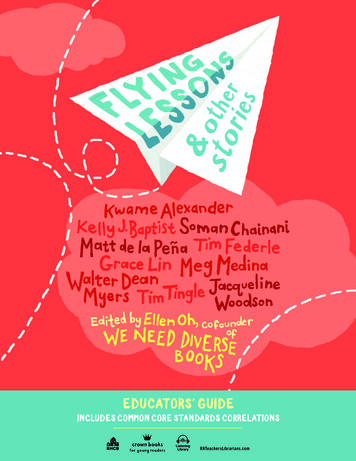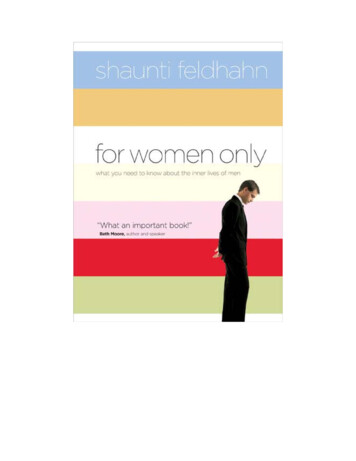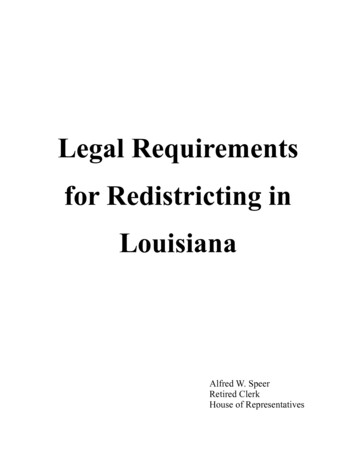
Transcription
EDUCATORS’ GUIDEINCLUDES CO ON CORE STANDARDS CO ELATIONScrown booksfor young readersRHTeachersLibrarians.com
WE ALL NEED DIVERSE STORIESABOUT THE BOOKGrades 3–7HC: 978-1-101-93459-3GLB: 978-1-101-93460-9EL: 978-1-101-93461-6CD: 978-1-5247-2115-2The We Need Diverse Books movement shines a spotlight on diversestories and characters. In addition, the common humanity among allyoung people is celebrated. This short-story collection, written bypopular and award-winning authors, provides exciting discussionopportunities for educators and students. K. H. Campbell explainsthe power of short stories: “Students can really dig deep if theyhave a manageable-sized text.”1 English/language arts anthologytextbooks often feature short stories by authors who are not exactlycontemporary but have endured the test of time. Flying Lessons &Other Stories features characters, topics, and themes that not only willendure, but are also relevant to today’s young people and are writtenby known, contemporary authors.Short stories are excellent for classroom use and read-alouds.Educators can introduce literary elements and can use these shortstories as mentor texts for writing. All of these stories are exemplarsof the craft of writing, allowing teachers and students alike to hold amagnifying glass to this art.Each of these stories has a bold protagonist who, like all kids, wantsto be seen and validated. The characters are authentic; young peoplewill recognize themselves in them right away. This entire collectionadvances the mission of We Need Diverse Books, which is to “recognizeall diverse experiences, including (but not limited to) LGBTQIA, peopleof color, gender diversity, people with disabilities, and ethnic, cultural,and religious minorities.”2Contributors to this anthology include:Kwame Alexander, Newbery Medal winnerKelly J. Baptist, debut authorSoman Chainani, New York Times bestselling authorTim Federle, Lambda Literary Award winnerGrace Lin, Newbery Honor winnerMeg Medina, Pura Belpré Award winnerWalter Dean Myers, Printz Award winnerMatt de la Peña, Newbery Medal winnerTim Tingle, American Indian Youth LiteratureAward winnerJacqueline Woodson, National Book Award winnerKwameAlexanderKelly J.BaptistSomanChainaniTim FederleGrace LinMeg MedinaWalter DeanMyersMattde la PeñaTim TingleJacquelineWoodsonPhoto credits: Top (left to right) Pilar Vergara, Hulrick Baptist, David J. Martin,Rex Bonomelli, Alexander Ferron. Bottom: (left to right) Petite Shards Productions,Constance Myers, Heather Waraksa, Juna Nagle1. Campbell, K.H. (2012). “Less Is More: Teaching literature with short texts—grades 6 -12.” Stenhouse Author Conversations,Stenhouse Publishers Podcast. Podcast retrieved from omain stenhouse.com.2. We Need Diverse Books, Mission Statement: How We Define Diversity. Retrieved from weneeddiversebooks.org/mission-statement.
D IS C U S S IO N Q UE S T IO N S“How to Transform an Everyday,Ordinary Hoop Court into a Place ofHigher Learning and You at the Podium”MA DE LA PEÑAThe story of a boy who, through the game of basketball,learns fundamental life lessons on and off the court.Before readingWhat have you sacrificed in order to get better atsomething?Who do you turn to for advice? How does thisperson help you? Describe him or her.The story is written in second person. In what waysis having readers assume the role of the narratoreffective? Why do you think de la Peña wrote thestory this way?During readingBasketball and the court represent more than thegame and a space to play. Readers learn early in thestory that to “you” basketball is “more than justball. It’s a way out.” (p. 2) Share how the Muni Gymin Balboa Park is the place “where you will learnthe world.” (p. 9)What does the narrator mean by this: “If you letit, [the lazy part] of your brain will hold you backfrom every dream you will ever have.” (p. 5)The episode with the police officer in the parkinglot alludes to complex issues between people ofcolor and law enforcement. The narrator’s fathertells him, “Mexicans are allowed to sleep, too.” (p. 8)Why does this make the narrator feels closer to hisfather?Describe the ways in which Dante and the narrator’sfather use silence to impart wisdom.After readingDiscuss the title of the story. Why is it appropriate?What could have been an alternative title?Correlates to Common Core Standards CCRA.R.1, 2, 4; CCRA.W.1, 3;CCRA.L.3, 4; CCRA.SL.1, 3.AN D ACTI VI TI ES“The Difficult Path”GRACE LINThe story of Lingsi, a resourceful girl who uses herability to read to overcome the burdens of servitude andimprisonment by pirates.Before readingIn a journal, write about a time when you overcamea hardship or difficulty.During readingLingsi is sold to be a servant in the Li familyhousehold. What is the significance of the ancestralshrine refusing to light on her sixth birthday and ofthe arrival of the new tutor?The new tutor presents the poem “The DifficultPath” by Li Po to Lingsi and FuDing. What doesthis poem mean to you? What images does it evoke?How does the poem foreshadow Lingsi’s “endlesshardships . . . and valiant spirit”? (p. 27)The Li household travels to the Infinite StreamTemple to make a sacrifice in hopes of finding abride for FuDing. Pirates arrive and the caravan isovertaken. Describe the pirates’ captain, Tiang.Discuss the importance of Tiang’s discovery thatLingsi can read. What does each person gain fromthis realization?After readingExplore the role of reading (literacy) in this story.In what ways does learning expose the difficult,but eventually right, path?Explore the importance of gender roles in thisstory. How does getting an education and earninga position of power disrupt the traditional genderroles that existed during the time of the story?Correlates to Common Core Standards CCRA.R.1, 2, 6; CCRA.W.3, 5,9; CCRA.L.3, 4.
“Sol Painting, Inc.”“Secret Samantha”MEG MEDINATIM FEDERLEA story that reminds readers of the sacrifices parentsmake so their children can have opportunities that wouldotherwise be unavailable.This story shows how the perfect gift for the new girlfrom the not-so-new girl creates a friendship.Before readingIn a journal, respond to the following questions:Have you ever tried to find the perfect gift forsomeone? What was that process like?What do you do during the summer? Do you go tosummer school? Do you spend time with family?In a journal, write about a time when you weredisappointed by a person you admired.During readingMerci and Roli help their father with his paintingbusiness. Why is Roli apprehensive about paintingat Seaward Pines the week before school starts?What are Merci’s interests? How is she differentfrom her older brother, Roli?Upon arriving at Seaward Pines for the painting job,Merci goes to the secretary in the office. She noticesthat the secretary, who unlocks the gym, does notacknowledge Roli. “You’d think she’d say helloto one of their A students, but maybe she doesn’trecognize him in overalls.” (p. 50) Why is this lackof acknowledgment important to Merci?Some girls burst into the gym where Merci, Roli,and Papi are painting. They ignore the “Wet Paint”signs, and they speak to them in condescendingSpanish in mock apology. Compare and contrastPapi’s, Roli’s, and Merci’s reactions to this episode.After readingRoli tells Merci, “Try to let this idea into your thickcranium. Papi chose to be invisible today so youwon’t ever have to be.” (p. 59) Discuss this momentbetween the siblings.What sacrifices would you make to allow your lovedones to prosper?Correlates to Common Core Standards CCRA.R.1, 2, 6; CCRA.W.3, 4;CCRA.L.4; CCRA.SL.1, 3.Before readingDo you have a nickname? What is the story behindit? If you don’t have a nickname, what name wouldyou want, and why?During readingThe story is written in the first person, from Sam’sperspective. What does she reveal about herself?Describe Blade. Why is Sam fascinated by her?Blade and Sam’s class is engaged in a secret giftexchange called Secret Sharers. Why did Sam havedifficulty finding Blade the perfect gift? Why wasSam heartbroken when she received a purse fromher secret sharer?How does Sam feel about school? On the day of thegift exchange, why is Mom surprised when Samtells her she “want[s] to get to school”? (p.78)Describe the ways Sam and Henry are good friendsto each other.After readingComplete the story: Will Sam and Blade becomebest friends? Does Sam now have someone who“gets” her?Describe your best friend or someone you want tobe your best friend.Correlates to Common Core Standards CCRA.R.1, 2, 3, 4; CCRA.W.3,5, 9; CCRA.L.3, 4; CCRA.SL.1, 3.
“The Beans and Rice Chroniclesof Isaiah Dunn”“Choctaw Bigfoot,Midnight in the Mountains”KE Y J. BAPTISTTIM TINGLEReaders meet Isaiah Dunn, a young boy who assumesresponisibility for his family and discovers a storyauthored by his deceased father that opens up his world.Before readingWhat do you do to escape from reality? Write in ajournal? Draw? Read? Play video games? Explainwhy your chosen activity is effective for you.During readingRead the first paragraph. Mama says, “This gonnabe one of them years.” (p. 87) What feelings do youhave after you read this?Describe the relationship between Charlie andIsaiah.Since the death of Charlie and Isaiah’s father, theDunn family has had a hard time. Their motherhas been despondent and has been drinking morealcohol. The family was evicted from their homeand forced to move to a motel. How do thesechallenges manifest themselves in Isaiah’s behaviorat school?Isaiah discovers the story “The Beans and RiceChronicles of Isaiah Dunn,” which was written byhis father. In the story, Isaiah gains superpowerswhenever he eats his mom’s rice and beans, travelsaround the world to help kids in danger, and isasked by the president to help with secret missions.How does reading this story bring Isaiah closer tohis father?After readingIn times of difficulty, the library was a place ofsolace for Isaiah. The youth services librarianbuilt upon that feeling of stability. Draw parallelsto libraries remaining open during unrest inFerguson, Baltimore, and other cities. Why is thelibrary’s remaining open significant?If you had a superpower, what would it be? Isaiaheats beans and rice to activate his superpowers—how would yours be activated?Correlates to Common Core Standards CCRA.R.1, 2, 3; CCRA.W.3, 9;CCRA.L.4; CCRA.SL.3.A large, jovial family with an exuberant uncle and quickwitted nephew are celebrated in this story.Before readingDiscuss the traits of a good storyteller.Have a storytelling celebration. Invite students toshare a story with peers.During reading“We’re Choctaws and we have our own ways, trustme.” (p. 106) Describe the family. How would youcharacterize Uncle Kenneth?Why does Turtle Kid’s mother say, “You knowbetter than to listen to anything that man says”?(p.105) What does Uncle Kenneth think aboutTurtle Kid’s mother?Uncle Kenneth tells the tall tale of Choctaw andNaloosha Chitto to the narrator (Turtle Kid) and therest of the cousins. Sketch this tall tale as a comicstrip or storyboard.How can you tell that Uncle Kenneth is a popularstoryteller?How does Turtle Kid joke around with UncleKenneth?Turtle Kid joins the storytelling at the end ofthe story. Why is this passing of the storytellingtradition important?After readingHow is family celebrated in this story?Does family have to be confined to relatives? Whatdoes family mean?Correlates to Common Core Standards CCRA.R.1, 2, 3; CCRA.W.3, 5;CCRA.L.3, 4, 5; CCRA.SL.1, 3.
“Main Street”“Flying Lessons”JACQUELINE W DSONSOMAN CHAINANITwo girls are at the center of this story whichdemonstrates the devastation of solitude, silence,and stereotypes.Before readingA boy and his grandmother take a memorable trip,during which he learns that there is more to life thanwinning school awards: it’s about being with people whomake us smile and expand our horizons.Have you ever moved to another town and feltlike an outsider? Describe that feeling, or anothersituation that may have evoked a similar emotion.Before readingAs a class, brainstorm and create a Venn diagram tocompare and contrast growing up in the city versusthe country.During readingDuring readingThe first paragraph describes Peterborough, NewHampshire. (p. 123) How do you think Celeste feelsabout living here? What are her apprehensions?How would you describe the narrator’s feelings atthe conclusion of the first paragraph? Explain yourrationale.Celeste and the narrator share a quiet momenton her swings. The narrator misses her mother,who passed away. Celeste says, “I know me somemissing.” (p. 128) Why is this moment significant?What does it foreshadow?Why doesn’t Celeste like living in Peterborough?Give examples from the story that highlight herdifficulties.After readingContinue the story. Imagine that Celeste and thenarrator meet in New York City when they turneighteen.Read Jacqueline Woodson’s picture book EachKindness. Compare and contrast the book and thisshort story. What is an enduring lesson of bothnarratives?Correlates to Common Core Standards CCRA.R.1, 3, 9; CCRA.W.3;CCRA.L.3, 4; CCRA.SL.1, 3.Describe your favorite (real or imagined) trip. Whatmade it extraordinary?The first part of the story introduces readers toNani and her grandson Santosh. Describe eachcharacter’s personality. What textual evidencesupports your views?Why does Santosh have a difficult time makingfriends?Nani brings Santosh on this trip because he “[wins]too many awards at school.” (p. 141) What doesshe mean by this statement? Why do you supposeSantosh felt worse when he thought about theacademic recognition he’d earn at school afterturning down the opportunity to hang out withTomas and his friends?How are Santosh and Nani “two caged birds,searching for a way out”? (p.157)After readingAfter reading “Flying Lessons,” do you think aboutyour own ambitions or goals differently? Whatabout friendship?Write and perform a poem in two voices featuringNani and Santosh or Santosh and Tomas. Whatconversation would they have after the conclusionof the story?In a journal, discuss why “Flying Lessons” is anappropriate title for this story.Correlates to Common Core Standards CCRA.R.1, 2, 6; CCRA.W.1, 3, 4;CCRA.L.3; CCRA.SL.1, 3.
“Seventy-Six Dollars andForty-Nine Cents”KWAME ALEXANDERIn his intricate and playful poetry, Kwame Alexanderdelights readers in answering the question “What if Icould read people’s minds?”Before readingRead a collection of memoirs and explore thecharacteristics of the genre. What makes memoirsdifferent from autobiographies?Write a poem that describes the origin of orinspiration for your name.During readingMonk’s life is self-described as “just the same ol’boring, / uncool life that I’ve been living / for thepast 12 years.” (p. 165) Then something amazinghappens. Stop the story-in-verse here and predictwhat will happen.The flashback to his first crush Lisa Castillo showsMonk’s “complicated history / with girls.” (p. 167)How do you think this complicated historyforeshadows what his relationship couldbe with Angel Carter?The power of hearing people’s inner thoughts cameas a result of a bump on the head. How does Monkuse this power to his advantage with his friends?His teacher?The ultimate test of Monk’s powers comes when hebets Angel Carter a date to see Star Wars. Why ishis not revealing how much the hair appointmentcost (see the title) a revealing moment?After reading“Sometimes a Dream Needs a Push”WALTER DEAN MYERSReaders meet a boy who uses a wheelchair after anaccident and a quiet father consumed by guilt who arebrought together by the game of basketball.Before readingCreate a visual representation of guilt.Watch a video of wheelchair basketball.During readingThe imagery of Jim, Chris’s father, mumbling as if“chewing up his words to see how they taste beforehe lets them out” (p. 208) is striking. Create a visualrepresentation or a dramatic interpretation of thisdescription.In what ways does Chris’s father attempt to connectwith Chris once he joins a wheelchair basketballteam and league?Revisit the last paragraph of the story. Why doesChris’s dad return to mumbling?After readingThe image of a dream is evoked in LangstonHughes’s poems “Dream Variations” and “Harlem.”In what ways could these poems be paired with thisshort story?The relationship between father and son, Jim andChris, is a complicated one entwined with guilt.How does Jim work through the guilt?How does this story reflect the readers Walter DeanMyers was writing for?Correlates to Common Core Standards CCRA.R.1, 3, 6, 9; CCRA.W.1,3, 4; CCRA.L.3; CCRA.SL.1, 3, 4.Did the ending surprise you? What did Monkwhisper in Angel’s ear?What superpower would you want to have, andwhy?If you were writing a memoir, what would youchoose to write about? How would you write it?Correlates to Common Core Standards CCRA.R.1, 3; CCRA.W.1, 3, 4;CCRA.L.3; CCRA.SL.1, 3, 4.This anthology is dedicated toWalter Dean Myers, who believedthat young people need to seethemselves reflected in the pagesof the books they read.
TI ONLO OK IN G AT TH E EN TI RE CO LL EC INT H E C L AS S R O O MFOREWORD BY E EN OHPhoto Robin ShotolaIn the foreword, Ellen Oh shares astory about her pet. She is thrilledwhen she finds an abandonedkitten. What surprises her aboutthe new pet? Find evidence in thetext to support your response.Ellen Oh is thepresident ofWe Need Diverse Booksand author ofthe Prophecy SeriesWhy does George’s story come upat Ellen’s family reunions?What does the story about Georgehave to do with the Flying Lessonsanthology?Even though these stories are able to stand alone,they can also be read together. They are linked bycommon ideas that are important to young people,such as dealing with friends and family. In addition,the stories fundamentally support the notion thatkids want to be seen and validated; they recognizethe relief of having someone “get them.” The yearningfor this validation from peers, and from parents andother adults is real, and these short stories continueto advance the We Need Diverse Books vision of “[a]world in which all children can see themselves inthe pages of a book.”2 The following section givesexamples of discussion questions and activitiesrelating to the collection that enable young people tomake their thoughts and experiences public.Select your favorite short story. Why is it yourfavorite? What about this particular story standsout to you?The anthology includes biographies for eachcontributor and information about We NeedDiverse Books. (p.225) What did Walter Dean Myers mean when hesaid, “Reading is not optional”? Christopher Myers, who collaborated with hisfather, Walter, on many projects, wrote, “[Kids]see books less as mirrors and more as maps.”What do you think this means? Do you agreeor disagree? State your reasons.These stories are by popular authors who havewritten a vast array of books. Select an author andconduct an author study. For this formal project,you will read, research, and delve deeply into thework of one author. You are responsible for threecomponents: a research/oral presentation about the author,his/her inspiration(s), and his/her books an exhibition of eight to ten artifacts/objects,with short explanations of why you includedthem a brochure or handout highlighting works bythe author, key quotes, and other pertinentinformation that introduces your chosen authorto the classCreate a video trailer for an individual story or forthe entire collection. Use the multi-step process ofbrainstorming, information gathering, drafting,and publishing. Invite peers to give feedback.Share the finished project with the class.Write a memoir or short story based on a momentin your life that still has “emotional heat.” Thismoment, when thought about again, shouldgenerate feelings similar to those you felt when themoment happened. Why is the moment significant?Use the process of brainstorming, informationgathering, drafting, and publishing. Invite peersto give feedback, and publish their responses in acollection similar to Flying Lessons & Other Stories.Correlates to Common Core Standards CCRA.R.1, 2, 3,5, 9;CCRA.W.1, 3, 4, 5, 9; CCRA.L.1, 3, 4; CCRA.SL.1, 3, 4, 5.Praise for Flying Lessons & Other Stories: “A natural for middle school classroomsand libraries, this strong collection shouldfind eager readers.” —Kirkus Reviews, Starred “There’s plenty of magic in this collectionto go around.” —Booklist, Starred What did Walter mean when he wrote, “Thereis work to be done”? (p. 226) What doesEllen mean when she writes, “So our workcontinues”? (p. v)Guide prepared by Shanetia P. Clark, PhD, Associate Professor of Literacy,Salisbury University, MD.Random House Children’s Books School and Library Marketing1745 Broadway New York, NY 10019 01/17
asked by the president to help with secret missions. How does reading this story bring Isaiah closer to his father? After reading In times of diffi culty, the library was a place of solace for Isaiah. The youth services librarian built upon that feeling of stability. Dr


